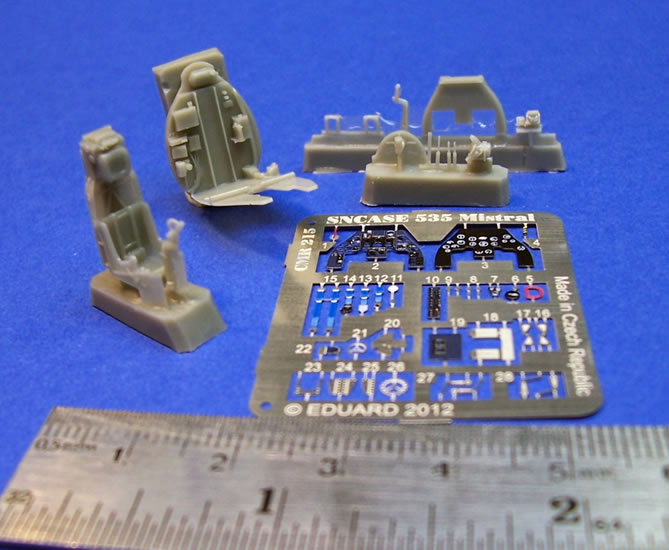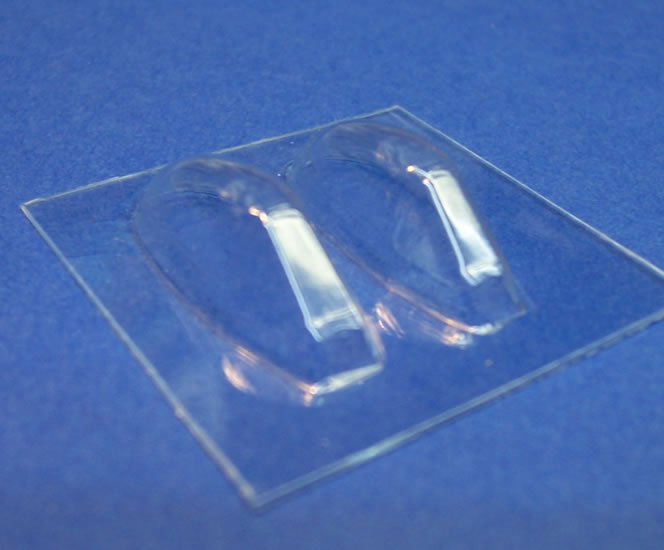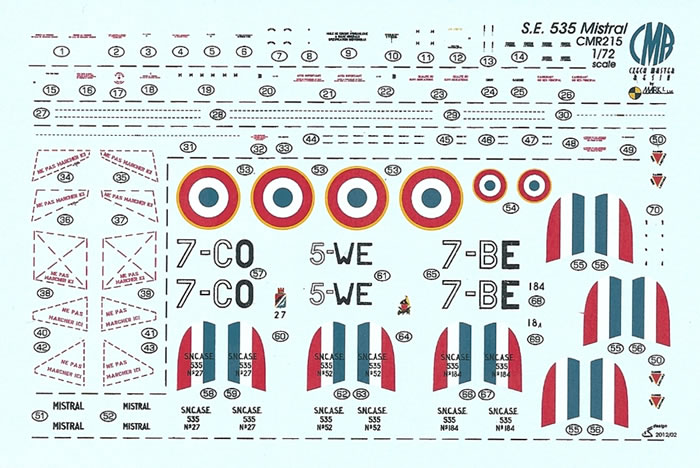S.N.C.A.S.E. SE 535 Mistral

Czech Master Resin, 1/72 scale
S u m m a r y : |
Catalogue Number: |
CMR Kit No. 215 - S.N.C.A.S.E. SE Mistral |
Scale: |
1/72 |
Contents & Media |
53 green resin airframe parts, 5 black resin undercarriage parts, 1 pre-coloured PE Fret of 33 parts, 2 vac-form canopies, 1 pre-cut canopy mask, and decal sheet covering 3 options. |
Price: |
Available from these on-line stockists: |
Hannants |
West Coast Hobbys |
Aviation Megastore |
£ 33.33 |
Can$ 49.00 |
€ 38.61 |
Click here for more CMR stockists and here for currency conversion. |
Review Type: |
First Look. |
Advantages: |
Accurate, well-researched, highly detailed, high production standards, excellent assembly diagrams, good blend of different media, pre-cut paint mask; this is just an extremely complete package in every way. |
Disadvantages: |
None apparent. |
Conclusions: |
This kit reflects thorough research combined with excellent production quality, and should build into a superb model without presenting too many challenges. I highly recommend it. |
Reviewed
by Mark Davies

HyperScale is proudly supported by Squadron.com
Background
Eager to join the jet age, France’s Armee de l’Air selected the De Havilland Vampire as its first jet. It acquired thirty Vampire F.1’s in late 1948, and ninety-four FB.5’s in May 1949. Meanwhile SNCASE had negotiated with De Havilland to assemble sixty-seven FB.51, which was an export FB.5, from De Havilland supplied parts. A licence-build of 120 more was to follow using French built components and a French licence-built Rolls Royce Nene engine in place of the Vampire’s usual De Havilland Goblin engine. This licence production would in fact more than double subsequently.
The Nene offered about sixty percent more power than the Goblin for only a 300-lb increase in weight. De Havilland had fitted the Nene to the Vampire and found that the Vampire’s intakes could not feed sufficient air to the bigger engine for its potential benefits to be realised. Trials using intakes based on those of the Nene powered Hawker Sea Hawk, which necessitated considerable inboard wing modifications proved most successful after several tries at modifying the mouths of the standard intakes had failed. However, De Havilland instead adopted a simpler fix developed by Rolls Royce consisting of two dorsal air scoops feeding air to the Nene’s rear impeller.
The dorsal scoops, referred to as elephant ears, enabled the engine to operate far more effectively, enabling the Nene-powered Vampire F.2 prototype to display the enhanced performance anticipated despite the elephant ears’ added drag. This enhanced performance was especially apparent below 15,000 feet because exceeding the aircraft’s critical Mach number could not occur even under full power, whereas above this altitude the engine had to be flown throttled back to avoid the problem. One problem that emerged however was a nose-down pitching induced at the aircraft’s critical Mach number, and problems with dive recovery due to elevator ineffectiveness. Despite these handling problems at the limit, the RAF placed orders early in 1945 for the Vampire F.2 and similarly powered F.4’s, only to cancel all Nene Vampire orders in September the same year.
The Australians did go onto to licence-build Vampires powered by Nene engines breathing with the assistance of elephant ears (the Vampire F.30 and FB.31). The RAAF subsequently relocated the elephant ears to the underside of their Vampires because this induced nose up pitch and so to avoided the sometimes-irreversible nose-down pitching moment that could occur beyond the aircraft’s critical Mach number. The downside of this measure was that the engine was prone to ingesting foreign objects as the scoops were very close to the ground.
With the British dropping their F.2 and F.4 plans, and the Aussies adopting Rolls Royce’s “patch-up” intakes, the French became the only producer of a Vampire airframe matched to the Nene engine without aerodynamic compromises. This was no doubt aided by the work De Havilland had already done using the Sea Hawk design intakes which I believe was sent to France, but nevertheless considerable modification and re-design of the airframe was still required.
The Societe Nationale de Constructions Aeronautique du Sud-Est (S.N.C.A.S.E.) manufactured the French Nene-powered Vampire under licence, with Hispano-Suiza producing the Nene under licence too. The French Nene-Vampire was initially designated FB.53, but the Vampire name was dropped and they named the aircraft the SE.535 Mistral.
Perhaps the most obvious external difference compared to all other Vampires was the Mistral’s wider straighter-mouthed air intakes, which also lacked any vertical bracing within, as was common to all other Vampires. Another feature absent from most other Vampires was the inclusion of an ejection seat, in this case made by S.N.C.A.S.O. Less obvious external differences the large openings in the airbrakes and a series of auxiliary inlet panels above the engine. These presumably enabled the engine to scavenge extra air when no ram-air effect was occurring through the wing intakes like those on the Nene-powered Hawker Sea Hawk. Far less obvious was the internal redesign and general aerodynamic cleaning up of the wing. This was in no small degree a bi-product of redesigning and relocating the enlarged capacity fuel system (of which there were fifteen tanks versus the FB.5’s nine). The Armee de l’Air also specified air conditioning to cope with North African deployments. In fact, only the tail-booms, horizontal stabilizer and forward fuselage remained the same as the Vampire FB.5.
SNCASE built four pre-production SE 532’s between June 1950 and October 1951, these initially lacked ejection seats, they then delivered the main production batch of 247 SE 535’s between June 1953 and February 1954. Some Mistrals served with France’s Aeronavale as well as the Armee de l’Air, but I could find few details of this naval service.
Previous 1/72 SE.535 Mistral kits
To the best of my knowledge, the only Mistral kit issued was by Heller and re-boxed by Revell (This kit also formed the basis of the Heller Vampire FB.5 re-boxed by both Airfix and Revell). It was a nice little kit for its time and typical of Heller in its heyday. It certainly still leaves plenty of room for improvement however nice it may still be.
Overview
The kit reviewed here is typical of CMR’s products released over the last few years. It is a multi-media offering with a highly detailed resin airframe, clear vac-form canopy, complimented by Eduard plain and pre-coloured PE parts, and pre-cut paint masks. A sturdy top-opening box contains all of the above media, water-slide decals and several sheets of A4-sized instructions and images.
The instructions acknowledge the assistance of Mistral experts from various countries and the major published references used in the kits’ development. CMRs global network of experts and enthusiasts is a major strength that underpins much of their quest for accuracy and high levels of detail.
Contents
The instructions contain a parts map and diagrammatic assembly stages as you would expect, but what is immediately apparent is just how crisp and well drawn the graphics are. I rate the constructional diagrams some of the best I have seen, mainstream kit brands included, and in fact Tamiya is the only company that I can think of that would rival them.
Written instructions are in English, and generally confine themselves to colour call-outs and simple clarifying statements where diagrams alone will not suffice. Where appropriate notes indentify features specific to the colour schemes offered with the kits. The colour scheme guides are three pages of monochrome shaded diagrams, and there is a one-page stencil placement guide. Colour call-outs use generic colour names cross-referenced to FS-595 numbers for both the interior detail and exterior finish. Two more pages provide various walk-around images of Mistral displayed at the Musee de l’Air in Paris, and one in-service image.
The kit parts come packed in CMR’s usual heat-sealed plastic pouches that separate the various resin parts broadly by size and fragility. PE parts, paint masks and canopies are further sealed and protected, as are the decals. An all-encompassing bag then encloses the entire kit parts and paperwork, so there is little chance of anything going missing until the kit is unpacked. However, I do advise care when opening the pouches containing resin, just in case some small parts have broken off their casting blocks or been damaged.
All of the resin parts are green except the undercarriage legs, which are a stronger black resin, as is common to most weight bearing parts in CMR kits. This black resin sometimes has a little flash that needs cleaning away. Easily removed casting blocks have thin attachment points, leaving only minimal cleanup afterwards. Detail levels are superb, with some incredibly fine and faultless casting. The regular and colour PE frets are produced to Eduard’s usual high standards, as is the paint mask. The kit includes two vac-form canopies, meaning you get to practice cutting out or have an insurance copy, depending on how you look at it. The canopies are very clear and well formed.
Airframe
The Mistral had an ejection seat manufactured by SNCASO that looks sufficiently different from the Martin Baker seats of the same period to add some extra interest to the model. Eduard pre-coloured PE belts garnish the seat and should look very good based on my experience using them with other CMR kits. The cockpit is very small but nonetheless replete with detail. A combination of resin and pre-coloured PE forms most of the detail, with a smattering of plain PE as well. Pre-coloured PE works very well in 1/72-scale in my opinion, providing levels of detail that only a few modelers could achieve with painting. Two small clear gun-sight reflector glasses need to be scratch-built. Some of the cockpit PE will need folding into small components, which will no doubt be a bit fiddly for some. However, a stunning looking cockpit will repay the effort made when finished.

The fuselage halves are ready for joining once fitted out with the cockpit, nose wheel-well and exhaust ducting. Do not forget to add some nose ballast at this stage; the instructions mention the need but not how much. I would suggest cramming all the lead shot that there is room for in the nose given the small space available, and perhaps consider a bit behind the rear bulkhead too. The Fuselage features the different panel lines and auxiliary intakes that are quite different to those of other Vampire family members.
It is fair to say that most of the constructional work lies with the wings for this kit (as it does with all CMR Vampires). This is because the separate flaps, airbrakes, intakes and undercarriage account for quite a few parts and will need some care with detail painting, stencil decaling and assembly.
The air-intakes are separate items that join to the wings, and are the feature that make the Mistral possibly the most elegant member of the Vampire family. The inlet ducting is most convincing, and ends in a hollow enclosed within the fuselage, which if painted mat black should provide a convincing degree of shadow within their depths. The wings incorporate highly detailed wheel and flap bays, both with authentic and delicate undercuts. The wheel door interiors capture the look of the originals well, as do the black undercarriage legs and green resin wheels, whilst PE scissor-links add to the overall scale refinement in this area. Closed or deployed airbrakes are also an option, and feature the openings in their surfaces that were unique to the Mistral within the Vampire family.
Two lugs on the wing-roots and their corresponding holes in the fuselage guide the wing to fuselage fit, whilst the intake ducting that nestles into openings in the fuselage helps as well. Some regard twin boom aircraft as a bit of challenge to build correctly aligned. However, CMR’s combination of tab and slot, plus crisply cast faces where the booms join the wings should ease this aspect as far as is practicable; and of course the square fit of the tail-plane also aids alignment. There is the option of fitting 100-gallon drop-tanks.
Many builders will leave a number of small components until the end of construction (the instructions also advise to do this). These include tail-fin pitot, elevator mass balances, two tiny gun barrel tips to fit into the rearmost pair of cannon troughs, and various small antennae that need to be scratch-built.

The kit has two very good vac-form canopies along with Eduard pre-cut masks for these, which is a nice feature of CMR’s kits, making painting just that little bit easier.
Colours & Markings
The kit options are a bit like Henry Ford’s Model T, except in this case you can have any colour you like as long as its overall aluminium. Fortunately, the Mistral looks quite smart in this colour (in my opinion at least). One decal option features red outer wing panels and horizontal stabilizer bullet fairings, whilst two others have yellow wingtips and bullet fairings. The French national insignia and unit markings also add a splash of colour.
The painting and markings guides provide colour call-outs using the colour name and equivalent FS-595 number in the case of the aluminium, but not for the red or yellow highlights mentioned previously. I would be inclined to match the colours to those used for national insignia in the absence of any other information.
Each scheme is catered for by a full A-4 page of monochrome four-view colour plans, with additional view of the inside fin surfaces, whilst a similar one-page guide covers stencil placement. The decals look to be very good quality. Registration is sharp, and my prior experience using CMR’s decals would suggest that they have good colour density as well.

The markings options provided are:
-
No.27, 7-CO, EC 2/7 "Nice", Bizerte-Sidi Ahmed, Tunisia 1959,
-
No.184, 7-BE, EC 1/7, Bizerte-Sidi Ahmed, Tunisia 1960, and
-
No.52, 5-WE, EC 3/5 “Comtat-Venaissin” Orange-Caritat, France, summer 1960.
Accuracy
The kit looks to be very good in terms of accuracy when compared to walk-arounds and in-service images. I have not made a comparison to plans, as I have no assurances regarding the accuracy of those to which I have access. I do have confidence in the thoroughness CMR put into their projects (and the fact that they have devoted an enormous effort to kitting the Vampire family), so I will be surprised if there are any glaring errors.
CMR obviously undertakes considerable research using wide-ranging network of people. Their expertise helps ensure highly detailed and accurate kits result. This is only the second1/72-scale kit of the Mistral, so I am sure French modelers will welcome such a good kit that raises the standards significantly from those set by Heller around thirty years ago. It should also appeal to Vampire builders everywhere who want to add the most refined and elegant of the Nene-powered versions to their collection.
This kit is a fine example of just how good resin multimedia kits can be. The detail and casting are excellent, as is the packaging, instructional graphics and additional information. These things combined should all add to the enjoyment of building the kit and hopefully the finished results. It should come as no surprise that I highly recommend it.
Thanks to CMR by Mark 1 Ltd for the review samples.

Review Text and Blue Background Images Copyright © 2012 by Mark Davies
Page Created 28 May, 2012
Last updated
28 May, 2012
Back to HyperScale Main Page
Back to Reviews Page
|
Home
| What's New |
Features |
Gallery |
Reviews |
Reference |
Forum |
Search